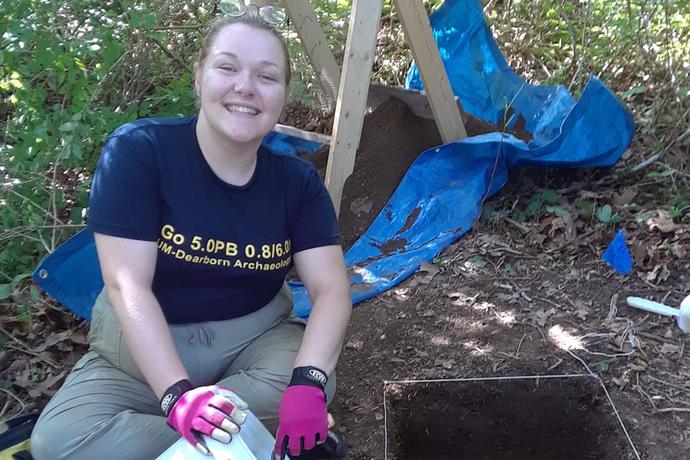
This article was originally published on September 11, 2019.
Materials from one of America’s first colonial settlements are in Associate Professor John Chenoweth’s archeology lab.
Chenoweth, along with 13 students, spent four weeks digging for their version of buried treasure — 350 year old trash. They worked at the Doane Memorial site in Massachusetts, which marks the homestead site of early English settler John Doane and his family. Doane and six other families were the first Europeans to permanently settle in Lower Cape Cod, being granted permission in the winter of 1644-45 and creating the town of Nauset (later Eastham) the following summer.
Looking through the trays of seventeenth-century red brick fragments, Chenoweth remarks on how surprisingly substantial the home was for the time and place — after all, Henry VIII used bricks a little more than a century before to impress when building Hampton Court Palace in England. And to take the time to make bricks in the new world — where you could have built a wooden shelter a lot quicker — would have only meant one thing: The settlers planned to stay.
Except — less than 50 years after Doane’s death in 1685 — it appears they left, starting new homes in the area.
Chenoweth, who frequented Cape Cod National Seashore — where the site is located— during childhood family trips, is exploring what remains there to learn more on why the settlers left and what we can learn from it today. A major research goal is to determine how the environment has changed since European settlers arrived in the mid-1600s. For example, what was once rich soil used by Native Americans for nearly 4,000 years became grainy sand shortly after colonists settled.
“When it came to land, Puritans had a specific idea about the relationships between land and people: They believed that God gave it to them for their use and that they had to ‘improve”’or ‘tame’ it.. But in less than two generations, their very different farming practices lead to deforestation and erosion, producing the famous sandy landscape that you still see in Cape Cod today,” Cheoweth says. “I’m interested in these environmental changes, and how these changes shifted religious beliefs, social structure, and economic systems on the New England frontier.”
Chenoweth’s research expands on archeological work that was started by the National Park Service in the 1970s, which confirmed that European settlers had lived at the location and that there were artifacts on the Cape Cod historical site. Using the map the NPS created, Chenoweth and his student crews spent their time digging for clues and cataloguing where each artifact was found.

Senior Stacey South was among the students in the excavation excursion. In addition to college credit received for the work, South says although the stuff found can be cool — that appeals to the art history major — she’s learned what’s more interesting is what it can tell you.
“We were looking at literal garbage. In the mid-1600s, when you broke something or it no longer had a use, you threw it out the window and it was covered with dirt. But that garbage can give you a bigger picture on what may have happened to someone,” says South who has a second major in sociology. “For example, a cow femur was found with the bone marrow scraped out. Professor Chenoweth shared that was indicative of the desperation there. That makes you feel something, it makes a person’s experience real."
And she appreciates how her experience with the 350-year-old trash can hold value for her future.
“You are learning about documentation, precision and teamwork. You are looking at items and finding connections on how or why they were used in the society,” she says. “Care with detail, accuracy and critical thinking are useful professionally and personally whether you are looking at the past or planning for the future.”
After Chenoweth’s year-long analysis, all property discovered at the Doane site will be given to the National Park Service. The dig was made possible by the Institute for Field Research.



